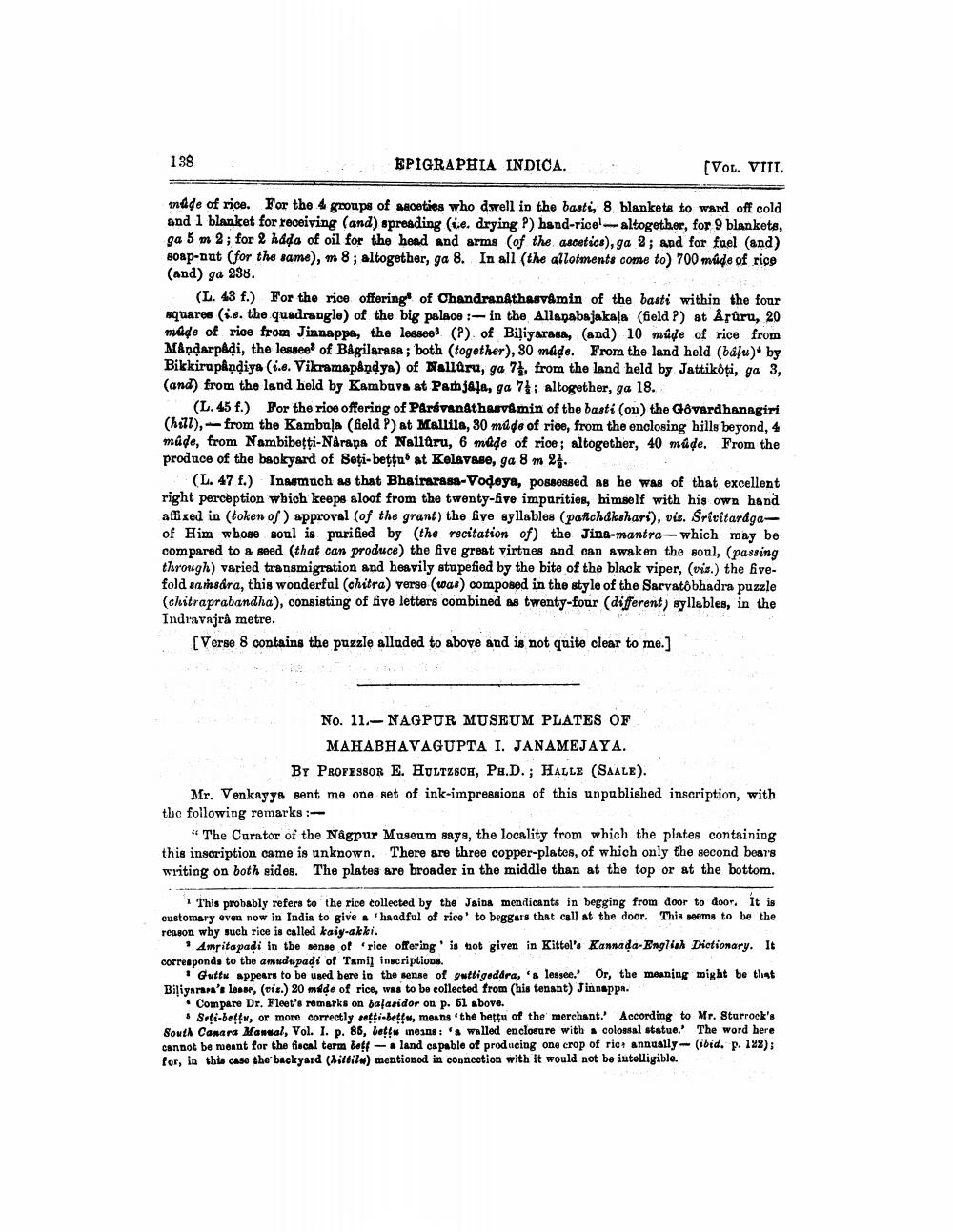________________
138
EPIGRAPHIA INDICA.
.
(Vol. VIII.
mude of rice. For the 4 groups of aceties who dwell in the basts, 8 blankets to ward off cold and 1 blanket for receiving (and) spreading (e. drying P) hand-ricel altogether, for 9 blankets, ga 5 m 2 , for 2 háda of oil for the head and arms (of the ascetics), ga ; and for fuel (and) soap-nut (for the same), m 8; altogether, ga 8. In all (the allotments come to) 700 múde of rice (and) ga 288.
(L. 43 f.) For the rice offering of Chandranathasvamin of the basti within the four squares (ie. the quadrangle) of the big palace :- in the Allaqabajakaļa (field P) at Årüru, 20 mide of rioe from Jianappa, the lesseed (P) of Biliyarasa, (and) 10 múde of rice from M&ņdarpadi, the lesseed of Bagilarasa; both (together), 80 made. From the land held (balu)" by Bikkirupândiya (i.e. Vikramapandya) of Nalluru, ga 7, from the land held by Jattikoti, ga 3, (and) from the land held by Kambura at Panjala, ga 7: altogether, ga 18.
(L. 45 f.) For the rice offering of Pargvangthasvamin of the basti (on) the Govardhanagiri (h:71), from the Kambala (field P) at Mallila, 30 mude of rice, from the enclosing hills beyond, 4 made, from Nambibetçi-Narana of Nalläru, 6 made of rice; altogether, 40 múde. From the produce of the backyard of Seti-bettu at Kelavase, ga 8 m 2.
(L. 47 f.) Inagmach as that Bhairarasa-Vodoya, possessed as he was of that excellent right perception wbich keeps aloof from the twenty-five imparities, himself with his own hand aflixed in token of approval (of the grant) the five syllables (pafichakshari), vis. Srivitardga of Him wbone soul is purified by the recitation of) the Jina-mantra- which may be compared to a seed (that can produce) the five great virtues and can awaken the soul, (passing through) varied transmigration and heavily stupefied by the bite of the black viper, (vis.) the fivefold samsdra, this wonderful (chitra) verse (was) composed in the style of the Sarvatóbhadra puzzle (chitraprabandha), consisting of five letters combined as twenty-four (different) syllables, in the Indravajra metre.
[Verse 8 contains the puzzle alluded to above and is not quite clear to me.]
No. 11.-NAGPUR MUSEUM PLATES OF
MAHABHAVAGUPTA I. JANAMEJAYA.
BY PROFESSOR E. HULTZSCH, PA.D.; HALLE (SAALE). Mr. Venkayya sent me one set of ink-impressions of this unpablished inscription, with the following remarks :
"The Curator of the Nagpur Museum says, the locality from which the plates containing this inscription came is unknown. There are three copper-plates, of which only the second bears writing on both sides. The plates are broader in the middle than at the top or at the bottom.
This probably refers to the rice collected by the Jaina mendicants in begging from door to door. It is customary even now in India to give haadful of rice' to beggars that call at the door. This seems to be the reason why such rice is called kaiy-akki.
. Amrita padi in the sense of rice offering is tot given in Kittel's Kannada-English Dictionary. It corresponds to the anadupadi of Tamil inscriptions.
1 Guttu appears to be used bere in the sense of gettigeddra, a lesgee. Or, the meaning might be that Biliynrara's losse, (vir.) 20 mide of rice, was to be collected from his tenant) Jinnappa.
Compare Dr. Fleet's remarks on balasidor on p. 51 above.
* Seti-beltw, or more correctly otti-bettw, means the bettu of the merchant. According to Mr. Sturrock's South Canara Manual, Vol. I. p. 86, bet ineins: '& walled enclosure with colossal statue.' The word here cannot be meant for the fiecal term belf l and capable of producing one crop of rich annually-(ibid. p. 122); for, in this case the backyard (Miltilo) mentioned in connection with it would not be intelligible.




